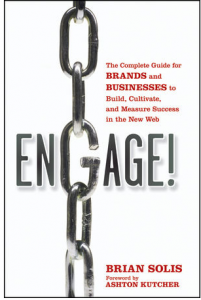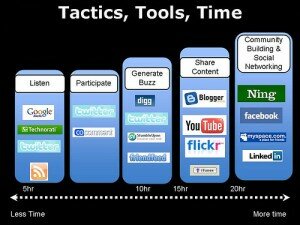Weber Media Partners | Impressions Through Media
Conversational Marketing in the Age of Social Media
- Home
- About This Blog
- Contact
- Sitemap
Archive for the ‘social media marketing’ Category
How Social Media Enabled Egypt’s Revolution: Part Two
Author: Theresa Grenier1 Jul
Two Can Play at this Game: World Governments’ Responses to Social Media as a Revolutionary Tool
 In the first part of this series, we explored how social media enabled and facilitated Egypt and Tunisia’s revolutions. By using Facebook and Twitter to broadcast their beliefs, find like-minded individuals the world over, and organize protests in near real-time, the revolutionaries were able to stay one step ahead of their governments. But now, it seems, the governments are catching up.
In the first part of this series, we explored how social media enabled and facilitated Egypt and Tunisia’s revolutions. By using Facebook and Twitter to broadcast their beliefs, find like-minded individuals the world over, and organize protests in near real-time, the revolutionaries were able to stay one step ahead of their governments. But now, it seems, the governments are catching up.
In Egypt, segments of the government and army are now on Facebook, using it as a means to spread their own propaganda and to keep an eye on known activist communities. At one point during the revolution, the Egyptian government even shut down internet access, fully aware of the threat it posed to the government. Amr Abouelleil, an Egyptian-American bioinformatics analyst and writer who is actively involved with the Egyptian Youth Movement at the heart of the revolution, says the government was aware that without the internet, people would have to turn to state television (which is government-censored) for their news. The government used this opportunity to up their ante, broadcasting pro-government programming to the unwired masses, which in many cases, appeared to work. “The government got some people to change their tune in just a matter of days,” Abouelleil says. “It brainwashed them to go back on Facebook in the government’s favor instead.”
Egypt is not the only government in fear of the power social media and the internet provides its people; when Google reportedly foiled an alleged Chinese attempt at stealing the passwords to hundreds of Google accounts, including those of government officials, Chinese human rights activists, and journalists. The Chinese government has since denied involvement, but is well known for their censorship of the internet and television. Whether or not the government is responsible for the hacking attempt, it’s safe to say that they are well aware of the power of the internet and social media, and doing all they can to control it.
Government reactions to the use of Google and social media have been so extreme in recent months that Google Executive Chairman Eric Schmidt has said he fears for the safety of Google employees in certain parts of the world. “There are countries where it is illegal to do things that Google encourages. In those countries, there is a real possibility of (employees) being put in prison for reasons which are not their fault,” Schmidt told attendees of Google’s Dublin summit on militant violence this past Monday, June 27.
A prime example of this is Wael Ghonim, the Egyptian Google executive who is now one of TIME magazine’s 100 most influential people of 2011. Ghonim was held captive by the Egyptian government for eleven days in early 2011 due to his involvement in using Facebook to organize protests via a page called “,” which exposed and raised awareness of the military’s cruel and inhumane murder of Khaled Saeed.
How Social Media Enabled Egypt’s Revolution: Part One
Author: Theresa Grenier22 Jun
 For hundreds of years now, the printed word has given a voice to the people. It has enabled repressed religious groups to establish their freedom and independence, and allowed fledgling countries to organize the support and manpower needed to break free from their oppressive overlords. There are centuries of evidence that the pen is, indeed, “mightier than the sword;” but in our age of technology, it appears that the Tweet may be mightier than the pen.
For hundreds of years now, the printed word has given a voice to the people. It has enabled repressed religious groups to establish their freedom and independence, and allowed fledgling countries to organize the support and manpower needed to break free from their oppressive overlords. There are centuries of evidence that the pen is, indeed, “mightier than the sword;” but in our age of technology, it appears that the Tweet may be mightier than the pen.
We all know by now about the recent social-media fueled upheavals in Egypt and Tunisia; protestors took to the web to voice their views and organize protests, acts which ultimately led to a successful revolution. Social media has given people a larger, louder voice than ever before. It allows them to reach the like-minded in both their own country and across the world. And perhaps more importantly, they are able to do it INSTANTLY. Revolutions that would have taken 10, 20, 30 years in the days before social media can now occur in that many months. Protests that would have taken weeks or months to organize can now happen in hours.
Let’s take a look at historical past revolutions. The Protestant Reformation, for example, would never have been made possible without the invention of the printing press. Johannes Gutenberg’s invention allowed Reformation leader Martin Luther to write and publish his beliefs prolifically, without Church censorship, and to distribute them to his followers and like-minded individuals, thus thrusting the reformation to the forefront of the public consciousness. Within 6 years, half of the printed works in Germany were written by Luther.
Then there is the American Revolution. Without Benjamin Franklin’s postal service, would missives have had such wide-spread reach? An organized means of distributing written information was essential to the fledgling colonies breaking free of British rule, and again in establishing the United States as a nation.
So we can see that the printed word has long played a role in disseminating information about dissidence and revolution to the people of the world and inciting the public to action. The difference between then and now is that now the people have the ability to instantly act on that information and reach a global audience.
It is important to note that, contrary to what the media and some extreme social media advocates are saying, the recent uprisings were not, in fact, “caused” by social media. They were caused by political unrest, government and military abuses of power, and poor treatment of a country’s citizens, and those citizens being unwilling to stand for it. The revolutions were, however, enabled and facilitated by social media, and quite possibly might not have been successful without it.
Stay tuned in the upcoming weeks as we post parts two and three in this series, where we’ll explore the government’s reaction to social media’s involvement in the Egyptian revolution, and speak with an Egyptian-American who has been active in using social media to advance the revolution from his home in the United States. And as always, we welcome your opinions and comments on this post and the topics it covers!
*UPDATE*
Part 2 is now up. Two Can Play at this Game: World Governments’ Responses to Social Media as a Revolutionary Tool
Image: Gigi Ibrahim via Flickr
- 1 Comment
- Filed under: facebook, social influence, social media marketing, twitter, viral video, youtube
Learning Loyalty from the Grateful Dead
Author: Catherine Weber23 Aug
 In 2008, David Meerman Scott drew comparisons between social marketing and the Grateful Dead at the the first Inbound Marketing Conference in Massachusetts. Having seen dozens of Dead shows, my first in 1982, I immediately understood what he was talking about.
In 2008, David Meerman Scott drew comparisons between social marketing and the Grateful Dead at the the first Inbound Marketing Conference in Massachusetts. Having seen dozens of Dead shows, my first in 1982, I immediately understood what he was talking about.
This band did everything differently– they produced only 13 albums over 30 years but instead toured constantly, doing more than 2300 shows. They played different songs every night from their catalog of 500 and supported the fans need for live shows by letting them record from a special section in the audience. Their brand lives on more than 15 years after Jerry Garcia’s death, and new fans are discovering them even now.
So, when I heard that David and Brian Halligan of Hubspot had written “Marketing Lessons from the Grateful Dead: What Every Business Can Learn from the Most Iconic Band in History”, I knew I needed to review it here. It covers how the Dead did the marketing basics differently: Their unique brand, message and offering, their fans(customers), and finally, their business model and operations. It’s a perfect guide for CEOs and marketers to learn to think differently and create a break through brand.
(more…)
- 7 Comments
- Filed under: books, social media marketing, social media marketing, web 2.0
Nonprofits Need to Develop a Social Media Strategy
Author: Catherine Weber16 Jul
 Earlier this week I spoke on a panel of social media professionals to 70 executive directors and marketing staff of nonprofit organizations at Simmons College in Boston. The subject was Social Media: Tips and tools for using social media to build support for your mission. The event was organized by the Center for Non-profit Success.
Earlier this week I spoke on a panel of social media professionals to 70 executive directors and marketing staff of nonprofit organizations at Simmons College in Boston. The subject was Social Media: Tips and tools for using social media to build support for your mission. The event was organized by the Center for Non-profit Success.
We had a great group of panelists who provided a balance of tools, case studies and strategy. My task was to present on strategy. While everyone had a Facebook presence, only two or three audience members had a strategy to back up their social media activities. This is common amongst most nonprofits and many for-profits. Unfortunately, without a strategy in place, these organizations may not be creating content that serves their audience, delivers on their organizational objectives or have the triggers in place to understand how successful their programs are.
(more…)
- 1 Comment
- Filed under: facebook, nonprofit, social media marketing, social media marketing
The Internet! [Infographic]
Author: Debbie Hemley5 Jul
A new Infographic with facts and visual perspective on the Internet:
Via: Medical Coding Certification
- 3 Comments
- Filed under: social media marketing
The Risks of Doing Nothing: Social Media for Healthcare
Author: Catherine Weber6 May
 Social media can have an impact on health care organizations, whether the organization has proactive programs or passively chooses to ignore it. By doing nothing, hospitals are at more legal risk because no clear guidelines articulate how staff should participate in social communities, how doctors share medical advice on blogs and where patients get medical information.
Social media can have an impact on health care organizations, whether the organization has proactive programs or passively chooses to ignore it. By doing nothing, hospitals are at more legal risk because no clear guidelines articulate how staff should participate in social communities, how doctors share medical advice on blogs and where patients get medical information.
Andrew Cohen of Forum One, recently wrote about the session he attended at the South by Southwest Interactive Conference, which identified legal issues as the top concerns of hospital administrators. Second to this is “lack of comfort with social media by administrators as well as staff…”
With patients helping themselves to information on websites that may or may not be good information, hospitals and other healthcare organizations like lifecare facilities have an opportunity to help guide patients and their families to good information and support.
In fact, every department needs to consider how social media effects them including human resources, legal, marketing, IT, patient services, and each and every medical specialty. In 2009, we met with many of the SVPs at a major teaching hospital north of Boston, Lahey Clinic, to give them a sense of what they need to think about.
(more…)
- 1 Comment
- Filed under: blogging, social media marketing, social media marketing, web 2.0
Brian Solis’s ‘Engage! The Complete Guide for Brands and Businesses to Build, Cultivate, and Measure Success in the New Web—Review
Author: Debbie Hemley18 Mar
 In Brian Solis’s new book, Engage! The Complete Guide for Brands and Businesses to Build, Cultivate, and Measure Success in the New Web, he uses the metaphor of “new media university” to take the reader through the basics and onto a more advanced education. As he says, “We are forever students of new media.”
In Brian Solis’s new book, Engage! The Complete Guide for Brands and Businesses to Build, Cultivate, and Measure Success in the New Web, he uses the metaphor of “new media university” to take the reader through the basics and onto a more advanced education. As he says, “We are forever students of new media.”
See what’s in the book.
In 2010, there’s an overabundance of social media tools at our disposal. However, Brian Solis cautions us to keep what’s important in the forefront, namely, content.
He writes about the need for producing compelling content as a way to gain and earn friends/followers. He reminds us that everyone in a company plays a critical role in communicating the brand; and to be effective in social media, a company needs to engage as a team. Consumers want a meaningful way to connect, and businesses must be ready to listen.
Brian Solis offers the Conversation Prism, a visual representation of social networks, and the Social Marketing Compass which he created with Jesse Thomas. These are invaluable resources and will serve as guides as you embark on developing a social media plan, as well as in your efforts to garner the support and participation of the organization.
The author does much more than simply introduce us to social media tools. Engage! is truly an education. If you take the time to do your homework, trying out the suggested resources, your efforts will pay off. There’s something for everyone in this book regardless of where you are on the new media learning curve.
I found myself captivated by several things in particular: social media dashboards, aggregation and syndication, geo location and mobile networking, social objects and social media optimization. Engage! is a book you will be able to pick up on any given day and find what you’re looking for as a way to keep on track with your social media goals and objectives.
At Impressions through Media, we’ll be talking with Brian Solis about the book and then posting part two with our Q &A. If you have any questions you’d like to add to the list, suggest them here. We’ll include your name and link back to you.
This is the first of two posts on Engage! by Brian Solis.
- Integrated marketing tools organized by categories and instruments
- Content communities, social bookmarking and livecasting
- Multimedia, Forums/Groups and url shorteners
- Social media dashboards
- Aggregation and conversational threading in activity feeds, lifestreams, microblogs and microcommunities
- Geo location and mobile networking, widgets and applications, video broadcast networks
- Social objects (as the connection of abstract objects that trigger and host related dialogues and activities), Social media optimization
- Syndicating social objects and aggregation networks
- Establishing an online presence, shaping the brand persona
- Real-time web and tapping into the statusphere
- From Web 1.0 to 2.0 and ultimately to web squared
- Online reputation
- Talking with meaningful exchanges
- Policies and guidelines
- Rules of engagement
- The Conversation Prism
- Listening and searching the social web
- Differing levels of participation
- Creating a social media plan, using a social marketing compass
- Social Media as a team effort
- Social relationship management
- Earning friends and followers/buying friends and followers
- Return on participation, experience and influence
* DISCLOSURE OF MATERIAL CONNECTION Special thanks to John Wiley & Sons for providing a review copy of Engage! for this blog post. Wiley books are available at your local bookstore or by calling .
- 0 Comments
- Filed under: books, social media marketing
When More isn't Always Better: Assessing the Effectiveness of Your Social Media Spaces
Author: Debbie Hemley10 Mar
 Blogger, Rich Brooks, raises many good points in his recent post, Social Media Marketing: Are You Spread to Thin?
Blogger, Rich Brooks, raises many good points in his recent post, Social Media Marketing: Are You Spread to Thin?
Brooks suggests that with the influx of social media spaces that companies may feel they need online presences everywhere. “If social media is keeping you from doing your job, it’s time to re-evaluate.”
These days many companies are using feeds to publish to multiple locations. For instance, when I publish this post it will automatically show up on the wall of our Facebook Fan by importing the rss feed to notes, it will also appear as a tweet on a twitter facebook by using involver , and by using the WordTwit plugin for WordPress blogs it will post to our page. If you want to publish to substantially more locations than these you can use a service such as ping.fim where over 40 social sites can be updated at once.
(more…)
- 0 Comments
- Filed under: social media marketing
Catherine Weber to Speak at Geek Girl Boot Camp Cape Cod—March 6th, 2010–Hyannis, MA
Author: Debbie Hemley5 Mar
Weber Media Partner’s President, Catherine Weber, will be speaking tomorrow at Geek Girl Boot Camp Cape Cod – March 6th, 2010 – Hyannis, MA. Join her for a Primer on Social Media, and to learn about the Power of Facebook, Twitter, YouTube and LinkedIn for your business. Promises to be a great day!
- 2 Comments
- Filed under: facebook, linkedin, social media marketing, twitter, youtube
Chrome, Buzz and Bing: The New(er) Kids on the Block
Author: Debbie Hemley5 Mar
 With so much to keep up with in social media and technology these days we asked Weber Media Partner, Jackie Mosher, to tell us what she’s learned about some of the newer kids on the block–Google’s web browser, Chrome, and their social media venture, Buzz, and Microsoft’s search engine, Bing.
With so much to keep up with in social media and technology these days we asked Weber Media Partner, Jackie Mosher, to tell us what she’s learned about some of the newer kids on the block–Google’s web browser, Chrome, and their social media venture, Buzz, and Microsoft’s search engine, Bing.
DH: What are your impressions of Google’s new browser, Chrome?
JM: Fast! Based on my experience, it is markedly faster than Internet Explorer.
DH: Are you able to do everything that you can with other browsers?
JM: Chrome isn’t able to run all web applications. For example, with Chrome I can run a Blackboard program and flash programs like Hulu’s video player. However, I can’t view a Webex meeting or log into a demo program.
DH: What do you think about Chrome’s approach as a cloud computing operating system?
JM: There are a lot of network effects that will make this transition hard for people since most workplaces rely on Word, PowerPoint, Outlook and Excel, and as a result they can’t unilaterally make the decision to switch over to Google’s free cloud versions of these programs. That being said, Chrome’s cloud computing OS is a key signal of where Google wants to go this decade, and there’s a lot of potential for cloud-based computing. It’s much faster, and much cheaper!
DH: Are there particular features you like about Chrome?
JM: I like what you can do with tabs. You can drag a tab away from the current window and into a new window which is something Internet Explorer and Firefox can’t do. Also when you open a new tab in Chrome it shows a thumbnail or list view of your most visited sites. You can customize themes, similar to Gmail and iGoogle’s homepage. This allows users to show off their individuality. and it can be changed as often as you change a Facebook profile picture, Twitter background or ringtone.
DH: What are your immediate impressions of Buzz?
JM: Buzz is integrated with Gmail and I like that you can get to it easily from the left-hand navigation whenever you’re logged in to your email account.
DH: How flexible is Buzz in terms of integrating with Twitter and Facebook?
JM: You can connect Buzz to your Twitter feed easily, but even though it only takes a few steps, I’ve noticed that my tweets don’t instantaneously appear in my Buzz feed. In one instance, there was a five hour delay. I’ve found connecting it to your Facebook status to be much harder.
(more…)
- 0 Comments
- Filed under: social media marketing
- Subscribe To Feed (RSS)
- Comments (RSS)
- Subscribe via Email




Recent Comments
Do businesses need both?